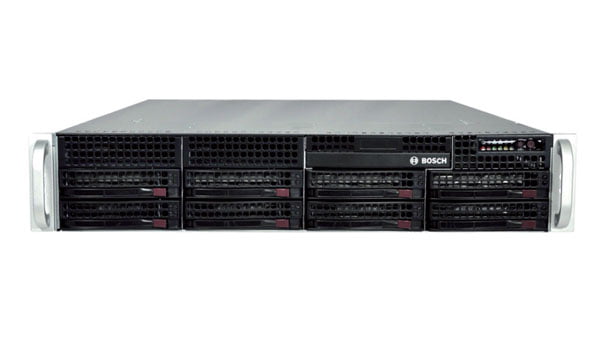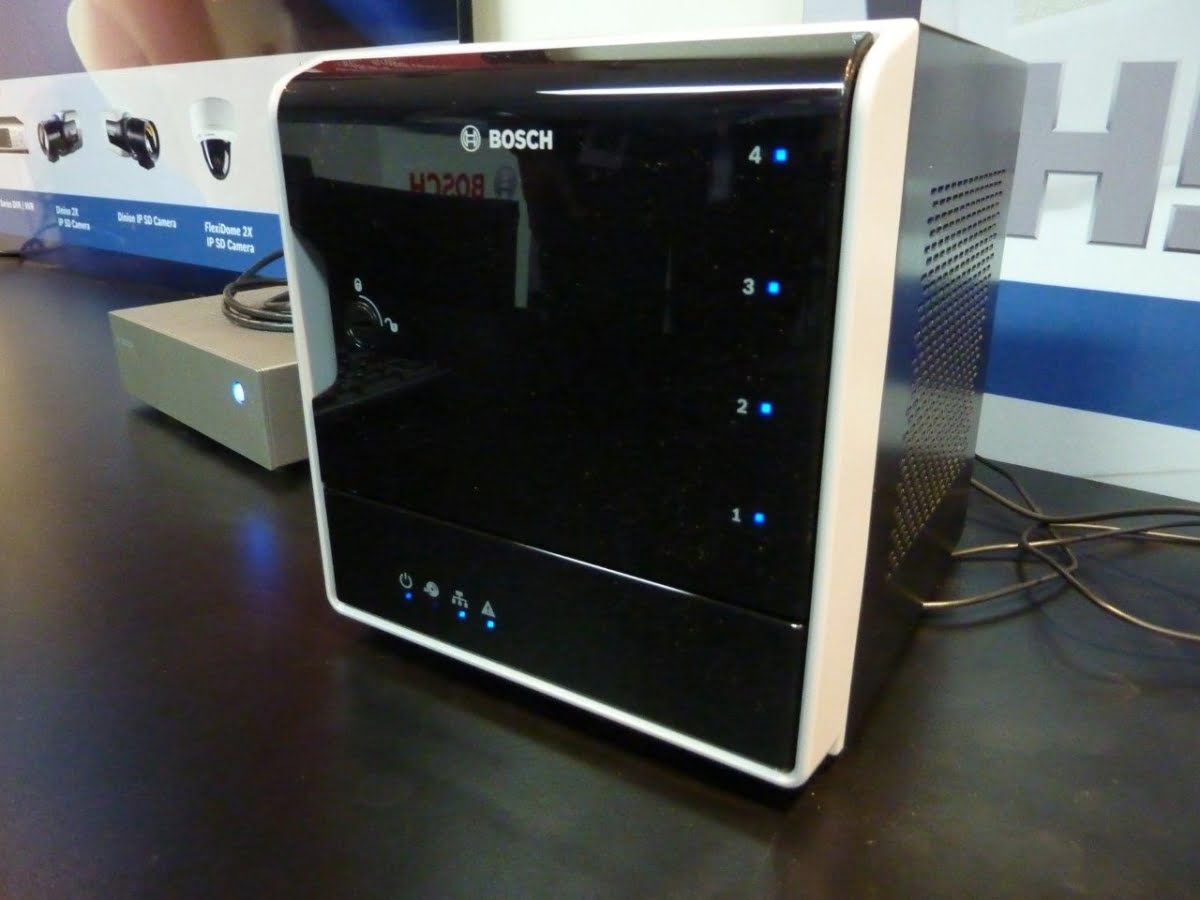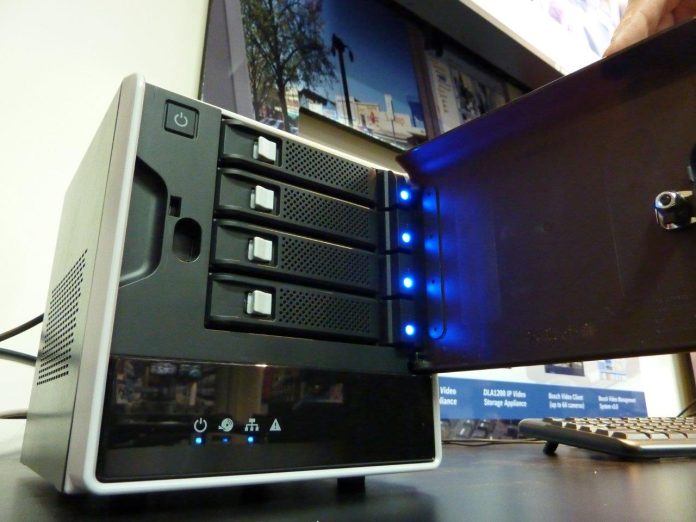A new DIVAR IP recorder family with integrated Dynamic Transcoding Technology has been released by Bosch. DIVAR IP is an all-in-one VMS and storage solution, with scalable recording and HD image quality from any location, even with limited bandwidth.
DIVAR IP from Bosch is the next generation of Bosch recorders and brings together the best of Bosch’s video recording and management technologies in one family. There are 4 recorders in the Divar IP range, the IP 2000, IP 3000, IP 6000 and IP 7000. In this review we’re looking at the IP 3000 and the IP 7000. DIVAR IP 3000/7000 recorders are equipped with Bosch Video Management Software and offer advanced alarm processing, integrated support for Forensic Search and Instant Detail Enhancement displaying paused images in full HD quality.
The core functionalities of Divar IP include recording, viewing, and export of high definition and standard definition resolution image streams. You view and manage image streams via remote either a remote operating client or an integrated operating client, or you can use a built-in web application.
An important aspect of IP 7000 is Bosch’s Dynamic Transcoding Technology which delivers high-resolution video streaming and playback live over limited bandwidth connections to mobile devices. The technology manages this by adapting the image quality to the available bandwidth and works with 3G and WiFi connections. Meanwhile, the Bosch Video Security app allows HD video from Divar IP installations to be viewed on an iPad/iPhone from any location.

Bosch’s Steve Malesevic
According to Bosch Security Systems’ Steve Malesevic, Divar IP 3000 is geared to the entry and mid-level market with up to 32 cameras and a very competitive price. Given it can support 32 cameras and 8TB of storage there’s a lot of power here and plenty of room for expansion. Same as the 7000, the 3000 can live in an enterprise environment and supports multiple authorised workstations.
We take a look at the 3000 hardware in Bosch’s Huntingwood demo room. In physical appearance, the 3000 is a NAS-style server unit with 4 HDD bays. It’s a clean-looking unit with a nice case and a group of LEDs on the front that indicate power, recording, the presence of the network and trouble. You drive the IP 3000 using Windows Storage server software that is easy for users to handle via kiosk mode and there’s a wizard that takes care of camera setup.
“The 3000 really simplifies installation,” explains Malesevic. “There’s management software and licenses included – you simply port this unit to a PoE network switch on one network cable and then point cameras towards it. It’s very easy. A smaller installation using the IP 3000 with a PoE switch and IP cameras would be well within the means of installers with basic IP understanding.”

Bosch DIVAR IP 7000
Meanwhile, Divar IP 7000 supports up to 128 cameras with inbuilt 24TB iSCSI RAID 5 storage with all the features of BVMS 4.5 in a single rack-mounted box. This is a powerful solution and it’s not just the muscular storage that’s appealing. The ability to support 128 cameras makes Divar IP 7000 capable of handling medium and larger installations while retaining the intrinsic simplicity of its younger sibling.
According to Malesevic, the IP 7000 comes with 32 camera licenses standard and users can upgrade as they need. Importantly, it’s a one-off fee to upgrade camera licenses. Again, the 7000 gets onto the network via a dual Ethernet ports, and cameras are installed across a subnet and accessed by multiple remote authorised workstations.
“While the rack-mounted Divar IP 7000 has its own storage and you can add additional storage using the Divar IP 6000 storage solution,” Malesevic explains. “The 7000 is powerful enough to handle up to 128 cameras as well as any additional storage required for higher frame rates and longer retention rates.”
Something that’s very Bosch is that both units are ope-ended in terms of expansion capability. This is unusual. Most systems like this would be a hassle to integrate into an enterprise environment.
“You might have multiple Divar IP units installed across a campus environment with the enterprise sitting over the top,” Malesevic says. “You can also have additional workstations attached to either system – you are not limited to just one user sitting beside the unit. There can be up to 5 remote users on the 3000 and 10 remote users on the 7000. These users are able to log into all the cameras in the entire system from authorised remote locations. In that way Divar IP lends itself to being highly expandable.”

Bosch Video Management System (BVMS) Version 4.5.9
Of course, no account of the IP 7000 would be complete without mentioning Bosch’s Video Management System (BVMS) Version 4.5.9, the included VMS that offers distributed IP architecture for enterprise applications, transcoding support for mobile devices, an SDK and full support for ONVIF’s Profile S.
Fully expanded, BVMS can manage more than 10,000 cameras and up to 100 operator client connections and the system allows authorized users access to cameras at any connected sites using workstations or mobile clients. Importantly, while BVMS 4.5.9 is designed to work with all Bosch surveillance products it supports all ONVIF Profile S conformant devices, including HD and megapixel cameras, too. That means BVMS is not a proprietary solution and having it loaded onto the Divar IP 7000 takes this solution to the enterprise level.
Local control of a video wall with BVMS is very intuitive – it’s drag and drop allowing the operator to design on the fly the layout of the video wall to meet changing needs. There are a range of screen layouts available and there’s a slider control on the top right of the screen allowing selection of the most common options. If you need to make an image larger, you can select a screen config that makes a scene bigger.
Other controls include timelines, snapshot functions, video export, print images and all the usual Jog/Shuttle type functionality we expect in a solution like this. Something else that I liked was CPU and RAM tachometers in the top right of the screen. These allow operators to check system load at a glance – especially if they notice a performance lag – allowing them to confirm cause.
Important, too, live and playback video can be shared between geographically distributed sites within one large entity or between installations belonging to different operational entities. That’s a neat feature that allows operational redundancy or sharing of operations with emergency services. Nice too, if you are doing a digital zoom, the system crops the un-zoomed part of the scene from the image stream and this reduces the bandwidth. The result is reduced bandwidth demand, higher resolution images on zoom, or faster performance on zoom.
Another BVMS feature I like is integrated alarm management that routes critical events to selected user groups. Supporting this feature is a map that’s positioned automatically in accordance with a selected camera. Overall the client is simple, familiar and functional. As part of the demo room Bosch has set up a video wall monitor adjacent to the client control workstation and this displays cameras of interest so they can be monitored at all times. This display is very clean with selectable display options.

In terms of wider operation, BVMS links authorized remote sites allowing what Bosch calls collaborative operations. This means there’s single sign-on for authorized operators that can include any combination of sites and systems. Once you’re authorised, off you go. Management is via a directory on the left hand side of the screen and you drill into the directory – multi-site root directory, select a site, then folders of camera group in a tree and then the remote site camera tree.
“BVMS is now a full enterprise solution and we’ve got access through iPad and iPhone with transcoding to manage different link bandwidths – that’s terrific for low bandwidth situations and it’s controllable with the mobile application. And all this is available with Divar IP 7000.
“Our transcoding is a great feature,” says Malesevic. “When the mobile device connects to the system, the system asks the mobile client how much bandwidth is available and then advises the optimum video stream it can transmit – that’s dynamic transcoding. The system is always asking what it is sending data to – you don’t have to set a hard limit, the system does this for you.
“We’ve also got access via remote connection – instead of a VPN we can get in over a routed network via a NAT – so just standard port forwarding – which is ideal for sites without a VPN. There’s also a video streaming gateway which allows us to record third party cameras that are ONVIF S compliant.”
“If there are multiple sites covering different time zones you can select a server and then choose to display the local time at the remote server or set it to time at the control room. This is important if images are going to be used as evidence,” Malesevic tells me.
Installing Divar IP
From the point of view of installers, the networked nature of Divar IP 3000 and IP 7000 means techs need some basic IP and networking knowledge but they are also designed to be as intuitive as possible.
“You don’t have to be a network administrator to get these solutions working,” says Malesevic. “Driving setup is a configuration wizard that appears on screen when the unit is powered up – it’s a simple 10-step process.
“The wizard asks questions like: ‘What is the IP address of this device going to be? ‘What computer name do you want to use?’ ‘Please select that cameras we have found during the automated network scan’ ‘Using checkboxes, what recording profile do you want to apply to those cameras – motion only, continuous, continuous plus motion?’, ‘Add users to the system and at what level of authorisation?’.
“Once that’s done, you just hit go and the machine will save the config, reboot, restart and begin recording.”
While many of the processes are simple, Malesevic says that depending on the nature of the installation and the overall infrastructure, installers are still going to need the services of the local IT administrator or their own IT people – especially if they need to program switches and/or create LANs with a small number of authorised workstations.
“You can’t do those things if you really only know the basics of IP,” he explains. “But for a standalone network environment with dedicated switches, you could do it yourself. And once you have your security subnet set up, you can then get the IT team to create a VLAN or subnet to the data network that makes the CCTV system available to authorised users via LAN or WAN using a gateway or a router.”
According to Malesevic, because there’s no external server, no storage array, no need for a separate workstation, in look and feel Divar IP is like a very powerful family of DVRs.
“Installers like things to be simple,” Malesevic says. “If you have to get a pencil out and draw a topology for a system of less 100 cameras, that’s going to be challenging for some installers yet to make the transition to IP. And that’s where Divar IP comes in.
“The setup wizard combined with big storage in the box so you don’t need to set up connectivity between server and an iSCSI unit means these are relatively simple solutions conceptually and in terms of topology. You get 24TB in one box with the 7000 (3TB HDD) and 8TB with the 3000 – that’s a lot of storage.
“You also have the operator client sitting in the box as well. Used standalone, the Divar IP family members feel like very powerful DVRs for IP cameras (or analogue cameras with encoders) that can expand or integrate into enterprise solutions if required. And thanks to BVMS with the IP 7000, you get all the features of a world class video management solution along with it.”
By John Adams








